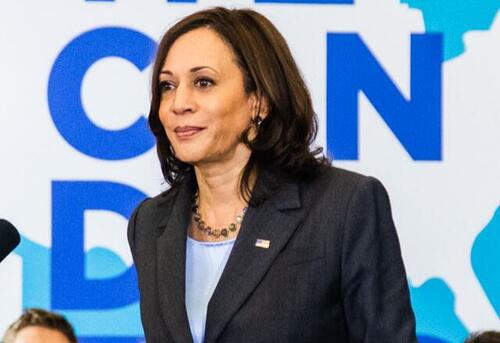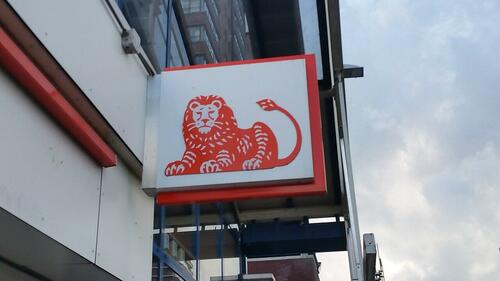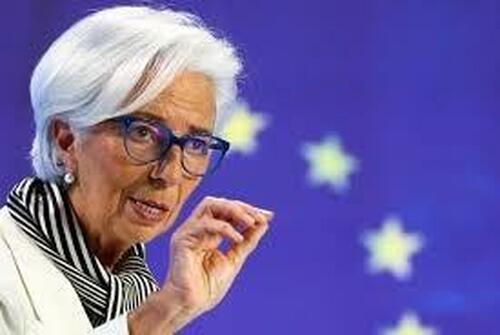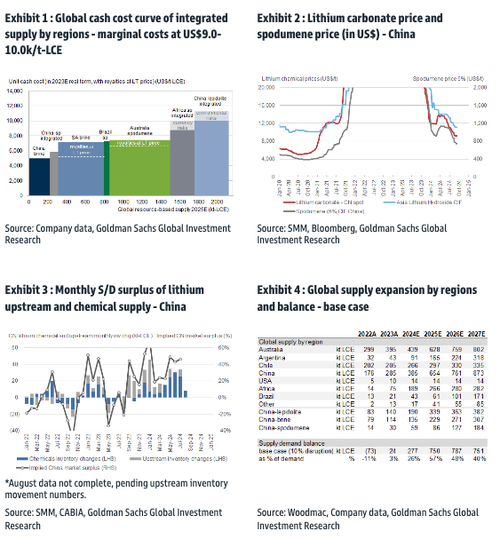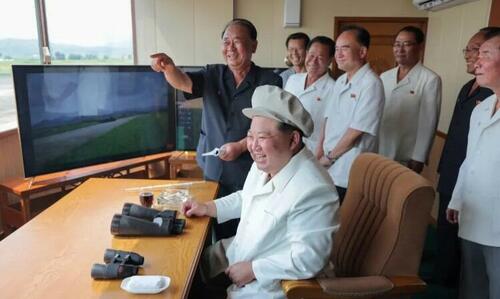Futures are trading higher ahead of today’s PPI report, extending on yesterday’s post-NVDA rebound momentum, as a rally that started in the US spread to stock markets in Asia and Europe Thursday as the Goldman Communacopia tech conference enters its final day. As of 8:00am, S&P and Nasdaq 100 futures are up 0.1%, with NVDA, GOOG, and META the top performers among MegaCap Tech. European stocks zoomed 1% higher led by Dutch chip-equipment maker ASML as traders braced for another rate cut by the European Central Bank. Asian stocks are also broadly higher with the exception of Chinese equities, which fell to the lowest since early 2019. Bond yields are higher, with the 10Y trading at 3.67% and the 2s10s curve is almost inverted again; the USD is flat. Commodities are mixed with Oil and Base Metals higher, while Precious Metals are lower. Today, the key focus will be PPI and Jobless claims: consensus est are for PPI to print 0.1% MoM vs. 0.1% prior and Core PPI to print 0.2% MoM vs. 0.0% prior. On earnings, keep an eye on consumer read-through from KR (before market-open) and AI/Tech sentiment from ADBE.

In premarket trading Moderna plunged 8% after the company plans to slash its R&D budget by about 20% over the next three years as the biotech tries to find a path to profitability. Here are some other notable premarket movers:
- Alaska Air rises 5% after the company increased its profit forecast for the current quarter, citing an improved revenue and fuel cost outlook.
- Caleres drops 15% after the footwear retailer reported 2Q sales and adjusted EPS that missed expectations and reduced its annual forecasts.
- Fulcrum Therapeutics sinks 69% after its phase 3 REACH trial failed to achieve its primary endpoint.
- Netgear surges 22% after the company raised its 3Q revenue guidance following a settlement agreement with TP-Link Systems over patents.
- Oxford Industries slides 10% after the apparel company cut its annual adjusted earnings per share guidance to a level below the average analyst estimate.
- Signet rises 9% after the company posted 2Q profit that topped estimates.
In corporate news, OpenAI is in talks to raise $6.5 billion from investors at a valuation of $150 billion, according to people familiar with the situation. Nvidia CEO Jensen Huang said the limited supply of their products has frustrated some customers and raised tensions. Alimentation Couche-Tard Inc. is discussing improving its takeover proposal for Seven & i Holdings Co. with the goal of convincing the Japanese convenience store operator to start engaging in discussions, people with knowledge of the matter said.
The ECB is poised for another move lower that would bring its key interest rate down a quarter-point to 3.5%. Still, policymakers are taking a cautious approach with inflation not fully vanquished. “We still expect the ECB to remain gradual in its approach, weighing the risk of growth and inflation,” said Camille de Courcel, head of European rates strategy at BNP Paribas SA.
The CPI report on Wednesday reinforced the view that the Fed will cut 25bps amid continued sticky shelter inflation.. Swap traders have fully priced in a quarter-point reduction at the Fed’s policy announcement next week, ditching bets on a half-point rate cut.
European stocks gain 1%, as traders’ attention turns to the European Central Bank’s interest rates decision today. Miners lead gains, boosted by rising metals prices, while semiconductor firms drive tech stocks’ outperformance. Health care and food and beverage stocks are the only sectors in the red. Among single stocks, Roche shares slid after its closely-watched experimental obesity pill was tied to side effects. Here are the most notable European movers:
- Europe’s mining sub-index jumps as much as 2.6%, the most in two months, boosted by rising metals prices. Glencore, Rio Tinto, Anglo American, KGHM Polska, Boliden and Antofagasta are among gainers.
- Spirit makers climb, led by Diageo following an upgrade at BofA Global Research, after analysts said they are turning selectively more constructive on the sector.
- DSV shares gain as much as 9.7% after Bloomberg News reported it’s finalizing the terms of an agreement to buy Deutsche Bahn’s logistics unit Schenker in a deal valued at around €14 billion.
- Alten shares climb as much as 6.6% after the technology consulting company was raised to outperform by BNP Paribas Exane analysts.
- IG Group shares rise as much as 2.2% after the trading platform’s first-quarter trading update showed a 15% rise in revenue from the year before thanks to increased volatility in the markets.
- Valeo shares rise as much as 6.7% and is the leading gainer on the Stoxx 600 autos index on Thursday following an upgrade to buy at BofA.
- Trainline shares jump as much as 12%, the most in six months, after the e-ticketing platform said annual adjusted Ebitda this year will exceed its guidance.
- NCC Group shares jump as much as 11%, the most in two years, after the cybersecurity company said it performed better than anticipated during the four months to the end of September.
- Roche shares drop as much as 5% in Zurich after its closely watched experimental obesity pill was tied to side effects, including nausea and vomiting, in a small study.
- Fevertree shares drop as much as 6.1% after the tonic maker reported first-half earnings that missed consensus estimates. Analysts flagged the impact of poor weather in Europe and the UK.
- Europe’s airline stocks fall after Reuters reported that Ryanair expects average fares 5% to 10% lower for the remainder of the year, citing the airline’s CEO Michael O’Leary.
- Edenred and Pluxee shares lose ground as analysts at Oddo BHF noted smaller peer Swile turned profitable for the first time ever during the first half of 2024.
Earlier in the session, Asian equities surged, snapping a three-day run of losses, boosted by gains in technology stocks. However, Chinese shares slumped to their lowest level since early 2019. The MSCI Asia Pacific Index advanced as much as 1.7%, the most in nearly a month. TSMC, Toyota Motor and Samsung were among the biggest contributors to the gauge’s gain. Japan’s Nikkei 225 Average halted a seven-day slump as the yen weakened, while benchmarks in South Korea, Taiwan, Hong Kong and Australia also closed higher. A regional gauge of tech companies jumped over 3% after Nvidia gained 8.2% following comments by the company’s CEO that it’s struggling to meet strong demand for its AI-related products. That spurred a broad intraday rebound in US stocks after an early dip as faster-than-anticipated inflation damped expectations for a half-point rate cut from the Federal Reserve next week.
In FX, the Bloomberg Dollar Spot Index was little changed as traders pared bets on the extent of Federal Reserve interest-rate cuts after the inflation data, almost pricing out the prospect of a 50 basis-point cut. EUR/USD climbs 0.1% to 1.1022; the central bank is forecast to cut for a second time this cycle as the region’s economy struggles to maintain growth momentum. USD/JPY rose 0.4% to 142.90 as the Nikkei 225 Stock Average rallied 3.5%. The pair fell as much as 0.1% earlier after Bank of Japan board member Naoki Tamura said policymakers will need to raise the benchmark interest rate to at least 1%
In rates, yields are cheaper by around 2bp across the curve amid similar weakness in bunds ahead of European Central Bank decision, with markets priced for a 25bp rate cut. 10-year TSYs are around 3.67%, with bunds and gilts in the sector also about 2bp cheaper on the day; curve spreads are within 1bp of Wednesday’s closing levels. Treasury’s three-auction cycle concludes with $22b 30-year reopening at 1pm New York time after two previous sales — $39b 10-year and $58b 3-year — drew strong demand; WI 30-year yield near 3.985% is 1.5bp richer than last month’s auction, which tailed by 3.1bp, a poor result
In commodities, oil extended gains from Wednesday as Hurricane Francine ripped through key oil-producing zones in the Gulf of Mexico, prompting traders to cover bearish bets. WTI drifted 1.4% higher above $68. Spot gold rises roughly $5 to trade near $2,517/oz. Most base metals trade in the green.
The US economic data calendar includes August PPI and jobless claims (8:30am), 2Q household change in net worth (12pm) and August monthly budget statement (2pm) Fed speakers are in self-imposed quiet period until the Sept. 18 policy decision
Market Snapshot
- S&P 500 futures little changed at 5,564.50
- STOXX Europe 600 up 0.9% to 512.67
- MXAP up 1.6% to 181.86
- MXAPJ up 1.5% to 564.62
- Nikkei up 3.4% to 36,833.27
- Topix up 2.4% to 2,592.50
- Hang Seng Index up 0.8% to 17,240.39
- Shanghai Composite down 0.2% to 2,717.12
- Sensex up 0.6% to 82,047.83
- Australia S&P/ASX 200 up 1.1% to 8,075.73
- Kospi up 2.3% to 2,572.09
- German 10Y yield little changed at 2.13%
- Euro little changed at $1.1018
- Brent Futures up 1.3% to $71.55/bbl
- Gold spot up 0.3% to $2,518.40
- US Dollar Index little changed at 101.74
Top Overnight News
- Japan’s PPI undershoots the Street in Aug, coming in at +2.5% Y/Y (down 50bp from +3% in Jul and falling short of the Street’s +2.8% forecast). BBG
- Western firms dramatically dial back on China investment plans due to a more inhospitable operating environment and slowing domestic growth. WSJ
- China could cut rates on >$5T worth of mortgages as soon as this month as the gov’t looks to bolster the economy. BBG
- Oil demand growth continues to “rapidly decline”, due primarily to weaker consumption in China (consumption in China contracted Y/Y for the fourth straight month in Jul), while supply on the rise. IEA
- China has detained at least three top investment bankers since August and firms have asked many more to hand in their passports, people familiar said. Regulators are said to be scrutinizing capital-raising activities, and some staffers were told they need approval if they wish to resign. BBG
- Brussels examines ways to refinance/roll over ~EU350B worth of joint debt issued during COVID to avoid a budget crunch going forward. FT
- US and UK are discussing whether to ease restrictions placed on Ukraine’s ability to launch strikes deeper into Russian territory. WSJ
- UniCredit CEO Andrea Orcel said all options are open for Commerzbank, including a possible takeover. His firm’s move should be no surprise as there’s room for consolidation in the German market, he said. BBG
- The ECB is set to cut rates again today, but will probably remain tight-lipped on the pace and extent of further action. The deposit rate will be decreased by 25 bps to 3.5%, with two other rates also be adjusted as part of a policy revamp unveiled in March. BBG
- Fed’s Office of Inspector General released a report on Atlanta Fed President Bostic’s (2024 Voter) financial disclosures in which it stated that Bostic violated Fed rules on trading and created an appearance of acting on confidential information, as well as created the appearance of a conflict of interest. However, it didn’t find evidence that Bostic traded on confidential information.
- Goldman Sachs CEO Solomon said he sees 2 or maybe 3 Fed rate cuts, while he added that they could see the possibility of a 50bps cut but his base case is for a cut of 25bps: CNBC
A more detailed look at global markets courtesy of Newsquawk
APAC stocks gained as the region took impetus from the post-CPI tech-led rebound stateside. ASX 200 advanced with strength in the tech and the energy sectors making up for the slack in mining stocks. Nikkei 225 outperformed on the back of recent currency weakness and softer Japanese PPI data. Hang Seng and Shanghai Comp were mixed as the former benefitted from the broad risk-on mood and with tech stocks inspired by their global peers, while the mainland lagged behind regional counterparts in the absence of any major pertinent drivers and amid protectionist policies with China said to have asked its carmakers to keep key EV technology at home.
Top Asian News
- BoJ’s Tamura said Japan’s neutral rate is likely to be around 1% at the minimum and the path toward ending easy policy is still very long, while he added they will carefully scrutinise the balance of pros and cons in exiting easy policy and must push up short-term rates at least to around 1% by the latter half of their long-term forecast period through fiscal 2026, to stably achieve the 2% inflation target. Furthermore, Tamura said the pace at which markets expect the BoJ to hike rates is very slow and hiking at such a pace could further heighten upward inflation risk, as well as noted that the likelihood of Japan sustainably achieving the BoJ’s price target is heightening further.
- China asked its carmakers to keep key EV technology at home, according to Bloomberg.
- South Korean aims to end short-selling ban on all stocks in March, according to Bloomberg.
- China’s CSI 300 index closes at the lowest level since early 2019.
- Chinese Commerce Ministry will visit Europe next week to discuss EV tariffs; Chinese Commerce Minister to meet with EU Commission Vice President on September 19th for talks, according to the Chinese Commerce Ministry.
- China is to reportedly cut rates on USD 5tln mortgages as soon as September to boost consumption; China to cut rates by up to 50bps, according to Bloomberg sources
European bourses, Stoxx 600 (+1%) are firmer across the board as the region catches up to the late gains on Wall Street which saw a surge in the tech sector, with NVIDIA closing higher by 8.2% on Wednesday, with the impact reverberating across APAC and now in Europe. European sectors are mostly firmer; Basic Resources is the clear outperformer amid the positive action in the base metals complex, overtaking the Tech sector which opened as the best performer following the strong performance on on Wall Street. Healthcare is dragged down by Roche (-4.2%) after its obesity-related updates. US Equity Futures (ES +0.1%, NQ +0.1%, RTY +0.4%) are modestly firmer and holding onto the significant gains made in the prior session.
Top European News
- UK Treasury refused to disclose key details of the GBP 22bln fiscal black hole that Chancellor Reeves claimed to have discovered, following a freedom of information request by the FT.
- Brussels explores Draghi option of extending up to EUR 350bln in EU debt as officials examine ways to roll over hundreds of billions of Covid-era bonds to avoid the common budget from being underwhelmed by repayment costs, according to FT.
- BoE has made “substantial amendments to our proposals in response to consultation feedback and evidence”. “In terms of the capital impact, the BoE said there will only be a very small impact on requirements, on average, across UK firms.”. “In some cases, changes were designed following “too much conservatism” in the original proposals, or where reforms were too difficult or costly to implement in practice.”
- Norges Bank Regional Network Report: expects activity to increase somewhat in H2 2024
FX
- DXY is steady after Wednesday’s trading session which saw a scaling back of bets for a 50bps Fed rate cut next week (currently priced at just 13%). Inflation will remain front of mind today with PPI metrics due on the docket.
- EUR steady vs. USD in the run-up to today’s ECB press conference which is widely expected to deliver a 25bps cut to the deposit rate. Focus will also fall on any guidance over future easing plans. EUR/USD is currently sat within Wednesday’s 1.1001-54 range.
- GBP flat vs. the USD with the pair contained within Wednesday’s 1.3001-1.3111 trading range. Fresh UK drivers remain light during today’s session and therefore it may be the case that the USD leg of the equation provides the greater source of traction for the pair with PPI and IJC due on deck later.
- JPY is the laggard across the majors despite hawkishly-perceived comments from BoJ’s Tamura overnight who followed suit from other policymakers this week alluding to the upward policy path at the bank. USD/JPY briefly traded on a 143 handle vs. Wednesday’s 140.70 trough.
- Antipodeans are both steady vs. the USD. AUD/USD attempted to extend on Wednesday’s bounce after the pair printed an MTD low at 0.6622. Currently, AUD/USD is back above its 100 and 50DMAs at 0.6649 and 0.6667 respectively.
Fixed Income
- USTs are a touch lower in an extension of Wednesday’s downside post-CPI which saw the curve flatten. Today’s docket holds US PPI (F) and the weekly jobless claims. The 10yr yield currently sits towards the top-end of Wednesday’s 3.605-689% range.
- Bunds are lower in the run-up to today’s ECB policy announcement which is widely expected to deliver a 25bps cut to the deposit rate and 60bps reductions in the main refi and marginal lending rates. Focus will also fall on any guidance over future easing plans; the German 10yr yield sits around the mid-point of Wednesday’s 2.086-2.157% range.
- Gilts are currently tracking losses in global peers with not much in the way of fresh UK drivers for today’s session. Focus for the UK will begin to turn towards next week’s UK CPI print which is followed up the next day by the latest BoE rate decision. UK 10yr yield is currently tucked within Wednesday’s 3.745-3.809% band.
- UK DMO sells GBP 2bln 0.125% 2026 Gilt via tender; b/c 4.17x, average yield 3.559%, yield tail 0.9bps
- Italy sells EUR 6.5bln vs exp. EUR 5.5-6.5bln 3.45% 2027 & 3.45% 2031 BTP
Commodities
- Crude is firmer and benefits from the broader risk-on mood across markets, whilst some desks also flag potential short covering after the market moved into “oversold” territory. Within IEA’s Oil Market Report, it cut its 2024 world oil demand growth forecast to 900k BPD (prev. 970k BPD). Brent Nov printed a USD 70.59/bbl trough before rising to a USD 71.87/bbl session high.
- Precious metals are firmer across the board but to varying degrees. Spot palladium briefly outperformed in the European morning whilst spot gold posts shallower gains ahead of the ECB decision. Spot gold trades in a narrow USD 2,511.09-2,522.36/oz range.
- Base metals are firmer across the board amid the continued revival across industrial commodities, with prices also helped by the broader risk-on mood.
- NHC announced that Francine became a category 2 hurricane as the eye approaches the Louisiana coast, with a life-threatening storm surge and hurricane conditions spreading onto the Louisiana coast.
- 39% of oil production and 49% of natgas production in the US Gulf of Mexico is shut, due to Hurricane Francine.
- Chile’s Codelco reached an early contract agreement with El Teniente union.
- Indian oil secretary wants OPEC+ to raise oil output; Indian Cos to maximise crude purchases from cheapest suppliers including Russia. Oil cos to consider fuel price cut if crude oil stays low for long.
- Russia attacked energy infrastructure in six regions in the past 24 hours, Ukraine’s energy ministry said.
- IEA OMR: cuts 2024 world oil demand growth forecast to 900k BPD (prev. 970k BPD), sees 2025 demand growth at 950k BPD; said “The rapid decline in global oil demand growth in recent months, led by China, has fuelled a sharp sell-off in oil markets”. “Outside of China, oil demand growth is tepid at best”. China is leading rapid decline.
- UBS said Hurricane Francine likely disrupted about 1.5mln barrels of US oil production; due to the hurricane, September production in the Gulf of Mexico will be reduced by some 50k BPD.
Geopolitics: Middle East
- Hamas said its negotiation team met Qatar’s PM and Egypt’s intelligence chief in Doha on Wednesday to discuss the latest Gaza developments. Furthermore, it reiterated its readiness to implement an ‘immediate’ ceasefire based on the US’s previous proposal without accepting new conditions from any party.
- Palestinian draft resolution at the United Nations demands that Israel end its illegal presence in the occupied territories and called for the establishment of a mechanism to compensate for the damage committed by Israel in the occupied territory, while the draft resolution is expected to be voted on on September 18th during the 10th session of the General Assembly, according to Al Jazeera.
Geopolitics: Other
- White House is finalising plans to expand where Ukraine can strike inside of Russia, according to POLITICO.
- North Korea fired a suspected ballistic missile which fell shortly after outside of Japan’s Exclusive Economic Zone, while the South Korean military later announced that North Korea fired multiple short-range ballistic missiles.
- Top Chinese general is to visit the US Indo-Pacific Command in Hawaii next week as the two militaries step up engagement, according to FT.
US event calendar
- 08:30: Aug. PPI Final Demand MoM, est. 0.1%, prior 0.1%
- Aug. PPI Final Demand YoY, est. 1.7%, prior 2.2%
- Aug. PPI Ex Food and Energy MoM, est. 0.2%, prior 0%
- Aug. PPI Ex Food and Energy YoY, est. 2.4%, prior 2.4%
- 08:30: Sept. Initial Jobless Claims, est. 227,000, prior 227,000
- Aug. Continuing Claims, est. 1.85m, prior 1.84m
- 12:00: 2Q US Household Change in Net Wor, prior $5.12t
- 14:00: Aug. Monthly Budget Statement, est. -$292.5b, prior -$243.7b
DB’s JIm Reid concludes the overnight wrap
Morning from Frankfurt and I’ve woken up to news that my daughter Maisie has been made U9 B-team netball captain at school for their first ever series of matches today. It’s her birthday on Monday and I’d bought her a netball hoop and ball. So I was slightly surprised to learn on text this morning as I woke up that my wife had let her open it early to practise given her elevated status in the B-team! In the unlikely event that the match isn’t being televised live in Frankfurt, I’ll await to see if it made a difference later!
After a few weeks of the ball running around the edge of the hoop before deciding whether to go in or not, yesterday’s US CPI report finally seems to have settled the 25 vs 50bps debate for the Fed in favour of 25. The main reason is that core CPI was at the upper end of expectations, coming in at +0.3% for the month (vs. +0.2% consensus). So when coupled with payrolls still running at +146k in August, the thinking is that the Fed won’t want to be too aggressive given that inflation is still (slightly) above target, and the current activity data simply isn’t pointing towards a recession whatever the risks might be.
That’s been reflected in market pricing, as immediately before the CPI print came out, futures were still pricing in a 31% chance that the Fed would deliver a larger 50bps cut next week. But by the close yesterday, that had come down to just 17%, which is the lowest since July 31, before the recent market turmoil had really kicked off. So investors aren’t completely dismissing the chance, but it would be a decent surprise from where things stand right now. Moreover, futures adjusted the profile of Fed rate cuts over the months ahead, and they now only see 106bps of cuts by Christmas, down from 115bps the previous day. This is the largest reversal in Fed pricing in four weeks but the market is still pricing nearly 150bps of cuts over the four meetings after September, which would be a historically aggressive easing cycle outside of recessions.
In terms of the details of the CPI print, headline CPI came in at +0.19% on the month, which took the year-on-year rate down to +2.5% as expected. That’s the lowest annual inflation rate since February 2021, before the inflation spike really got going, so that’s a significant milestone. But markets were more focused on the upside surprise for core inflation, which was running at a monthly pace of +0.28%. In large part, that was down to a rise in Owners’ Equivalent Rent, which came in at a 7-month high of +0.50% for the month. That OER component makes up just over a quarter of the overall CPI number, and around a third of the core CPI number, so it plays a big role. Today all eyes will be on the PPI reading for September, as several categories in that feed into the core PCE number that the Fed focuses on.
Given the shift in market pricing, it’s making it increasingly hard for the Fed to cut by 50bps without triggering a significant market surprise. After all, one thing that’s been evident throughout this cycle is that the Fed have consistently delivered the rate decision that markets were expecting on the day. Sometimes those shifted not long before the day, such as in June 2022 when they moved by 75bps rather than 50bps, and market pricing moved over the previous week. But even in that case, market expectations had adjusted by the time the decision was made. So if markets were expecting a 25bp cut on the day and the Fed then delivered 50bps, that would be a shock decision of the sort we haven’t seen at all in recent years.
US equities initially fell back sharply in response to the CPI print, with the S&P 500 trading -1.6% lower early on, but with a strong tech-driven rebound the index posted a +1.07% gain by the close. This marked the first time since October 2022 that the S&P 500 erased an intra-day loss of over 1.5%. The NASDAQ (+2.17%) and the Magnificent 7 (+2.62%) outperformed, with Nvidia (+8.15%) seeing its strongest day since July. However, the equity mood was more downbeat outside of tech, with more than half of the S&P 500 constituents down on the day, led by energy (-0.93%) and consumer staples (-0.88%) sectors. Another interesting theme was that the “Trump trades” generally didn’t do so well after the previous night’s debate. For instance, Trump Media & Technology Group fell -10.47%. By contrast, solar energy firms outperformed, including First Solar (+15.19%) and SolarEdge Technologies (+8.46%). European equities were little changed, with the STOXX 600 up by +0.01%.
For US Treasuries, the prospect of more gradual rate cuts helped to lift front-end yields, and the 2yr yield ended the day up +4.7bps at 3.64%. The 10yr yield saw a more modest increase of +1.0bps, only rising to 3.65%, but that still marked an end to 6 consecutive daily declines, having closed at 3.90% before the Labor Day holiday. By contrast, Europe saw an ongoing bond rally ahead of today’s ECB meeting, with yields on 10yr bunds (-1.8bps) falling for the seventh day in a row and to their lowest level since January at 2.11%.
In terms of that ECB decision today, it’s widely expected that they’ll deliver another 25bp rate cut, which would take the deposit rate down to 3.50%. So the bigger question will be what they signal about the subsequent steps in this easing cycle, and how fast they might cut rates from here. Our European economists’ baseline has a quarterly pace of cuts continuing in December and into 2025. But they see the risks as tilted dovishly over the next six months, as there is value in the ECB retaining optionality to ease faster if downside risks to inflation materialise. See their full preview here for more details.
This morning Asian equity markets are rallying for the first time this week and being fuelled by a tech rally. The Nikkei (+2.77%) is leading gains and halting a seven-day losing streak as the yen’s strengthening has paused for now while the KOSPI (+1.57%), the Hang Seng (+1.07%) and the S&P/ASX 200 (+0.60%) are also trading higher. Elsewhere, Chinese stocks have reversed initial gains with the CSI (-0.14%) and the Shanghai Composite (-0.05%) both seeing small losses. S&P 500 (+0.08%) and NASDAQ 100 (+0.12%) futures are edging higher.
Early morning data showed that Japan’s PPI rose +2.5% y/y in August, less than the expected +2.8% and down from the +3% gain reported the previous month. Meanwhile, the Japanese yen (-0.18%) is losing ground against the dollar, trading at 142.62, even with BOJ board member Naoki Tamura commenting that the bank needs to raise interest rates to at least 1% to avoid inflationary risks. Looking ahead, the BOJ is set to meet next week, with the consensus mostly expecting the bank to remain on hold for now.
Finally, looking at yesterday’s other data, UK monthly GDP was unchanged in July (vs. +0.2% expected). As a result, investors dialled up their expectations for BoE rate cuts over the months ahead, and gilts outperformed with the 10yr yield down -5.8bps.
To the day ahead now, and the main highlight will be the ECB’s policy decision, along with President Lagarde’s subsequent press conference. Other data releases include the US PPI reading for August, and the weekly initial jobless claims.


